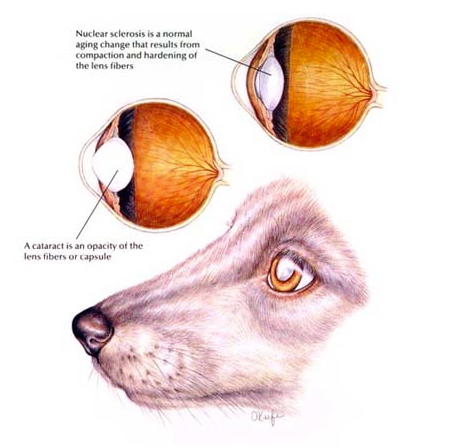The most common change noted in the eyes of the aging animal is lenticular sclerosis, or hardening of the lens. This is also sometimes referred to as nuclear sclerosis. This is a phenomenon well-known to humans - especially as they approach their fourth decade of life and come to rely on "reading glasses."
The lens essentially grows throughout life, gaining layers of protein. This process is similar to the growth of the layers of an onion. However, unlike an onion, the lens cannot continue to grow past a certain size, as the eye cannot accommodate it. Therefore, as new layers of protein are added, the older, inner layers of the nucleus are compacted together and become harder. The hardening of the lens fibers doesn't allow for the change in shape needed for focusing or accommodation. In humans, this becomes a problem. There comes a point where near vision becomes a bit difficult without the help of "reading glasses."
In dogs and cats it usually manifests itself at about eight to ten years of age. Pet owners may notice a cloudy appearance to the eyes with no observable change in vision. Lenticular sclerosis rarely causes any major vision change, just difficulty with depth perception. Of course, dogs and cats with sclerosis would benefit from bifocals, but we're not quite there yet.
Subtle changes, however, may be noticed by observant pet owners. Dogs may exhibit a hesitancy with stairways and may have difficulty determining how far down that first step is. Occasionally owners may see a decreased ability to catch toys, or an occasional nip on the finger tip when giving a treat. Dogs in their teens may "flinch" when approached due to the lack of depth perception.

Lenticular sclerosis is sometimes referred to as "senile cataracts," although this term can be misleading. A cataract is an opacity within the lens that obscures vision. With sclerosis, light passes through the lens (unobscured), but may just be refracted differently. The older dog with sclerosis may also go on to develop cataracts. Thorough examination of the patient is essential when clouding of the lens appears so as to determine if the animal will be a candidate for cataract surgery, if and when the cataract progresses.
Illustration reprinted with permission by the copyright owner, Hill’s Pet Nutrition, Inc.